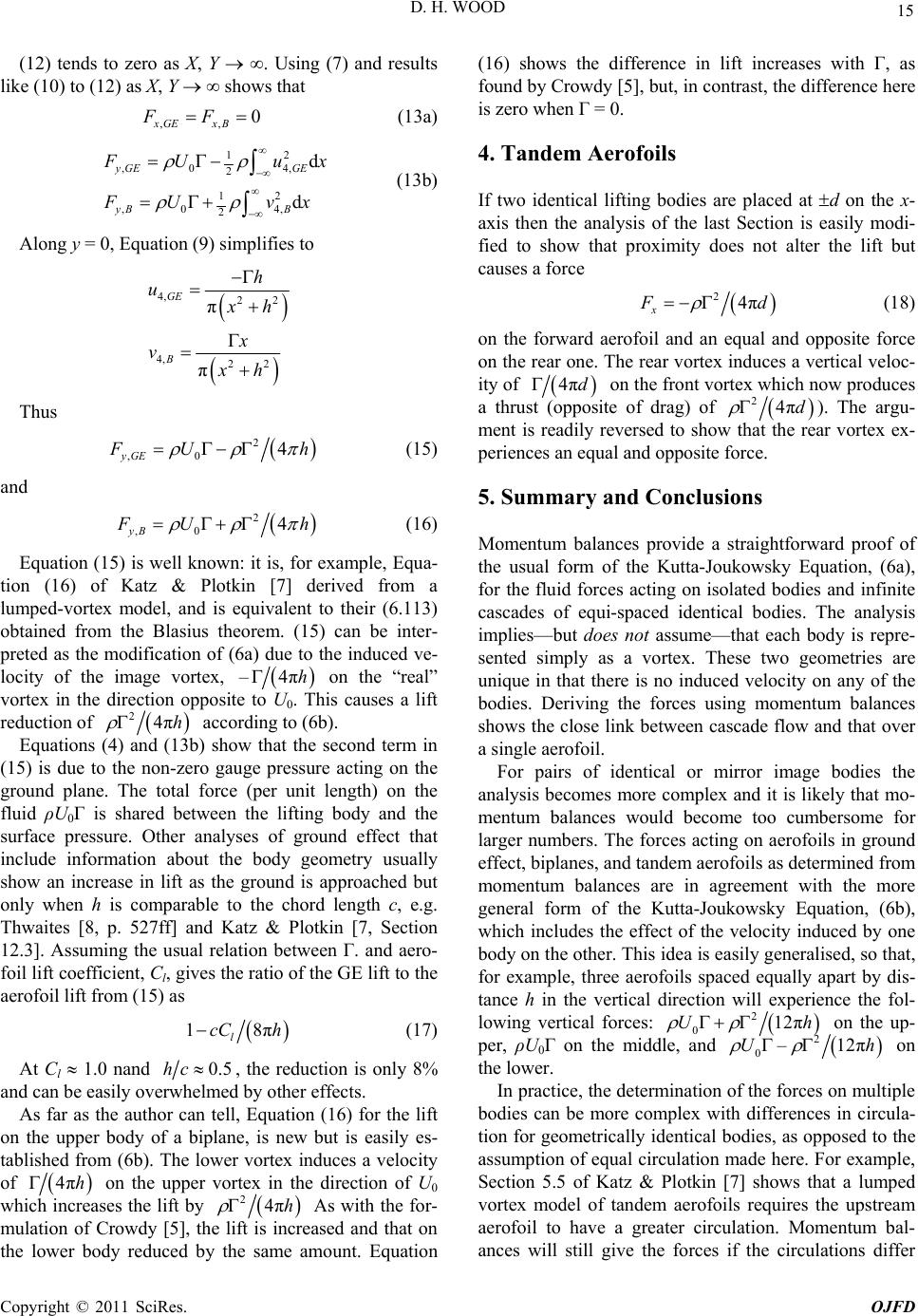
15
D. H. WOOD
(12) tends to zero as X, Y ∞. Using (7) and results
like (10) to (12) as X, Y ∞ shows that
,,
0
xGE xB
FF
(13a)
12
,0 4,
2
12
,0 4,
2
d
d
yGE GE
yB B
Uux
Uv
x
(13b)
Along y = 0, Equation (9) simplifies to
4, 22
4, 22
π
π
GE
B
h
u
h
x
v
xh
Thus
2
,0 4
yGE
Uh
(15)
and
2
,0 4
yB
Uh
(16)
Equation (15) is well known: it is, for example, Equa-
tion (16) of Katz & Plotkin [7] derived from a
lumped-vortex model, and is equivalent to their (6.113)
obtained from the Blasius theorem. (15) can be inter-
preted as the modification of (6a) due to the induced ve-
locity of the image vortex,
–4πh on the “real”
vortex in the direction opposite to U0. This causes a lift
reduction of
24πh
according to (6b).
Equations (4) and (13b) show that the second term in
(15) is due to the non-zero gauge pressure acting on the
ground plane. The total force (per unit length) on the
fluid ρU0Γ is shared between the lifting body and the
surface pressure. Other analyses of ground effect that
include information about the body geometry usually
show an increase in lift as the ground is approached but
only when h is comparable to the chord length c, e.g.
Thwaites [8, p. 527ff] and Katz & Plotkin [7, Section
12.3]. Assuming the usual relation between Γ. and aero-
foil lift coefficient, Cl, gives the ratio of the GE lift to the
aerofoil lift from (15) as
18π
l
cC h (17)
At Cl 1.0 nand 0.5hc, the reduction is only 8%
and can be easily overwhelmed by other effects.
As far as the author can tell, Equation (16) for the lift
on the upper body of a biplane, is new but is easily es-
tablished from (6b). The lower vortex induces a velocity
of
4πh on the upper vortex in the direction of U0
which increases the lift by
24πh
As with the for-
mulation of Crowdy [5], the lift is increased and that on
the lower body reduced by the same amount. Equation
(16) shows the difference in lift increases with Γ, as
found by Crowdy [5], but, in contrast, the difference here
is zero when Γ = 0.
4. Tandem Aerofoils
If two identical lifting bodies are placed at d on the x-
axis then the analysis of the last Section is easily modi-
fied to show that proximity does not alter the lift but
causes a force
24π
x
d
(18)
on the forward aerofoil and an equal and opposite force
on the rear one. The rear vortex induces a vertical veloc-
ity of
4πd on the front vortex which now produces
a thrust (opposite of drag) of
24πd
). The argu-
ment is readily reversed to show that the rear vortex ex-
periences an equal and opposite force.
5. Summary and Conclusions
Momentum balances provide a straightforward proof of
the usual form of the Kutta-Joukowsky Equation, (6a),
for the fluid forces acting on isolated bodies and infinite
cascades of equi-spaced identical bodies. The analysis
implies—but does not assume—that each body is repre-
sented simply as a vortex. These two geometries are
unique in that there is no induced velocity on any of the
bodies. Deriving the forces using momentum balances
shows the close link between cascade flow and that over
a single aerofoil.
For pairs of identical or mirror image bodies the
analysis becomes more complex and it is likely that mo-
mentum balances would become too cumbersome for
larger numbers. The forces acting on aerofoils in ground
effect, biplanes, and tandem aerofoils as determined from
momentum balances are in agreement with the more
general form of the Kutta-Joukowsky Equation, (6b),
which includes the effect of the velocity induced by one
body on the other. This idea is easily generalised, so that,
for example, three aerofoils spaced equally apart by dis-
tance h in the vertical direction will experience the fol-
lowing vertical forces:
2
012πUh
on the up-
per, ρU0Γ on the middle, and
2
0–12πUh
on
the lower.
In practice, the determination of the forces on multiple
bodies can be more complex with differences in circula-
tion for geometrically identical bodies, as opposed to the
assumption of equal circulation made here. For example,
Section 5.5 of Katz & Plotkin [7] shows that a lumped
vortex model of tandem aerofoils requires the upstream
aerofoil to have a greater circulation. Momentum bal-
ances will still give the forces if the circulations differ
Copyright © 2011 SciRes. OJFD